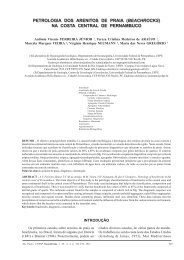flow structure and dynamics in large tropical river confluence - Unesp
flow structure and dynamics in large tropical river confluence - Unesp
flow structure and dynamics in large tropical river confluence - Unesp
You also want an ePaper? Increase the reach of your titles
YUMPU automatically turns print PDFs into web optimized ePapers that Google loves.
CONFLUENCE MORPHOLOGY AND SEDIMENTOLOGY<br />
The Ivaí River’s water does not <strong>flow</strong> directly <strong>in</strong>to<br />
the Paraná River ma<strong>in</strong> channel but rather <strong>in</strong> a secondary<br />
one formed by the Ivaí Isl<strong>and</strong> <strong>and</strong> its left bank (Figure<br />
2, 4). This type of mouth, with isl<strong>and</strong> formation <strong>and</strong><br />
<strong>flow</strong> diversion also occurs <strong>in</strong> the Paranapanema River<br />
at about 120 km upstream (Paes, 2007). It is probable<br />
that this k<strong>in</strong>d of mouth is related to sedimentary load<br />
<strong>and</strong> <strong>confluence</strong> angle. This situation is not observed <strong>in</strong><br />
the <strong>confluence</strong> of the Piquiri River (90 km downstream)<br />
or <strong>in</strong> the Paraguay River, near Corrientes, Argent<strong>in</strong>a<br />
(Orfeo et al., 2007). The studied <strong>confluence</strong> channels<br />
forms an angle of 45° <strong>and</strong> presents strong lithological<br />
as well as a structural control (Santos et al., 2008). A<br />
summary of <strong>confluence</strong> data is presented <strong>in</strong> Table 1.<br />
The thalweg <strong>and</strong> the channel of the Ivaí River are<br />
straight upstream <strong>confluence</strong>. In this reach, <strong>river</strong> runs,<br />
for the most part, over alluvial deposits with few po<strong>in</strong>ts<br />
as bedrock channel. The channel has width/depth ratio<br />
of 50 to 80 <strong>and</strong> thalweg depth ranges from 5 to 7 m.<br />
Bed load is composed of f<strong>in</strong>e to medium, well sorted,<br />
quartzose deposits <strong>in</strong> the form of ripples of 0.2-0.3 m<br />
height <strong>and</strong> 7.0-14.0 m long <strong>and</strong> with low mobility (Biaz<strong>in</strong>,<br />
2005). Suspended load ranged 21.0 to 6.8 mg/L (Kürten,<br />
2006); but values around 100 mg/L were found <strong>in</strong> Porto<br />
Paraíso, 100 km upstream from its mouth (ITAIPU<br />
BINACIONAL, 1990). Dur<strong>in</strong>g the field work, slight<br />
alterations <strong>in</strong> the Ivaí channel were observed,<br />
concern<strong>in</strong>g to channel morphology: thalweg s<strong>in</strong>uosity<br />
was slightly reduced from 1.3 to 1.1 from low to high<br />
water level <strong>and</strong> migrated discretely to its right bank,<br />
produc<strong>in</strong>g an asymmetrical channel section (Figure 5).<br />
RESULTS AND DISCUSSION<br />
The Paraná River channel is relatively shallow<br />
with width:depth ratio of 200 to 250. It is slight<br />
me<strong>and</strong>er<strong>in</strong>g <strong>in</strong> its last 1000 m upstream <strong>confluence</strong> <strong>and</strong><br />
changes to a straight channel after receiv<strong>in</strong>g the Ivaí<br />
waters. Channel depth is <strong>in</strong>ferior to that of tributary<br />
depth <strong>and</strong> varies from 3 to 4 m. Thalweg is not<br />
cont<strong>in</strong>uous but forms isolated <strong>and</strong> irregular pools. Bed<br />
material is formed by f<strong>in</strong>e to medium s<strong>and</strong> with local<br />
concentration of gravel. At upstream <strong>confluence</strong><br />
bedforms dunes of 0,3 to 1,5 m <strong>in</strong> height are formed<br />
(Figure 6).<br />
Downstream reach is straight <strong>and</strong> constitutes a<br />
cont<strong>in</strong>uity of the Ivaí River (Figure 5). This channel has<br />
a cont<strong>in</strong>uous <strong>and</strong> well-def<strong>in</strong>ed thalweg, with s<strong>in</strong>uosity of<br />
1.4 <strong>and</strong> do not changes along the hydrological regime<br />
(low <strong>and</strong> high water level). Thalweg s<strong>in</strong>uosity <strong>in</strong>duces<br />
the formation of lateral bars with about 500 m <strong>in</strong> length.<br />
The asymmetry between the tributary <strong>and</strong> collector<br />
channels depth is not common for <strong>large</strong> <strong>river</strong> systems<br />
(Biron et al., 1993). In this case the Ivaí channel is<br />
50% deeper than the Paraná. The same asymmetry<br />
was found by Paes (2007) <strong>in</strong> the Paranapanema River<br />
<strong>confluence</strong> 90 km upstream (Figure 1) <strong>and</strong> by Parson<br />
et al. (2004 a, b) <strong>in</strong> the <strong>confluence</strong> of the Paraguay<br />
<strong>and</strong> Paraná Rivers near Corrientes, Argent<strong>in</strong>a. The<br />
reason for this asymmetry is not well understood,<br />
however, Franco (2007) suggested, <strong>in</strong> the case of the<br />
Ivaí River <strong>confluence</strong>, neotectonics control as be<strong>in</strong>g<br />
responsible for the channel asymmetry. On the other<br />
h<strong>and</strong>, Orfeo et al. (2007) attribute only to <strong>flow</strong> <strong>and</strong><br />
sedimentary load <strong>dynamics</strong> the occurrence of<br />
asymmetrical <strong>confluence</strong> <strong>in</strong> the Paraguay-Paraná case.<br />
TABLE 1. Resume of the Ivaí-Paraná River <strong>confluence</strong> characteristic.<br />
São Paulo, UNESP, Geociências, v. 28, n. 1, p. 5-13, 2009 9



